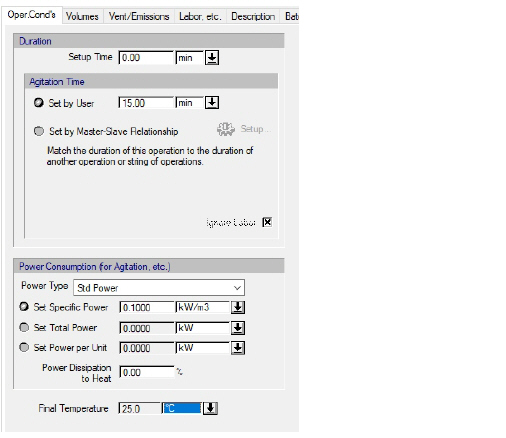

The following table shows a brief description of the variables appearing in this tab. The table also displays their default values and their generally acceptable range. Note that due to how the variables are used in the modeling equations, the range of acceptable values may be further reduced; for more details, see Agitation: Modeling Assumptions & Constraints.
|
Variable |
Default Value |
Range |
|
|
||
|
○ Setup Time |
0.0 |
Positive |
|
◙ Agitation Time |
0.0 |
Positive |
|
○ Ignore Labor? |
Yes |
Yes/No |
|
○ Power Type |
<Std Power> |
Any Power Type |
|
◙ Specific Power (kW/m3) |
0.1 |
Positive |
|
◙ Total Power (kW) |
0.0 |
Positive |
|
◙ Power Per Unit (kW) |
0.0 |
Positive |
|
○ Power Dissipation to Heat (%) |
0.0 |
[0,100] |
|
● Final Temperature (oC) |
25.0 |
Positive |
Symbol Key: ○ User-specified value (always input); ● Calculated value (always output); ◙ Sometimes input, sometimes output
The following list describes the available specification choices in this tab; for more details on how these are implemented, see Agitation: Modeling Calculations.
•If the Agitation Time is Set by User...
You must specify the agitation time (per cycle).
•If the Agitation Time is Set by Master-Slave Relationship...
You must setup a master-slave relationship between this operation and another operation. You have the option to set the duration of the operation to match exactly the duration of another operation either in the same procedure or in another procedure. The program will match the setup time, the process time and the turnaround time of this operation (the ‘slave’) with the corresponding times of the reference operation (the ‘master’ operation). For more details on how to setup a master-slave relationship, see The Scheduling Tab.
•If Specific Power Consumption is specified (Set Specific Power)...
You must specify the power consumed for agitation per volume of liquid processed. SuperPro Designer’s simulation engine will calculate the corresponding total power and power per unit.
•If Total Power Consumption is specified (Set Total Power)...
You must specify the total power consumed for agitation (per cycle). SuperPro Designer’s simulation engine will calculate the corresponding power per unit and specific power.
•If Power Consumption Per Unit is specified (Set Power Per Unit)...
You must specify the power consumed for agitation per equipment unit. SuperPro Designer’s simulation engine will calculate the corresponding total power and specific power.